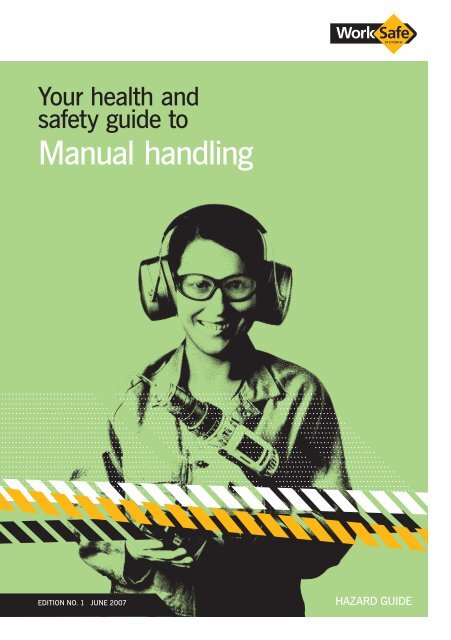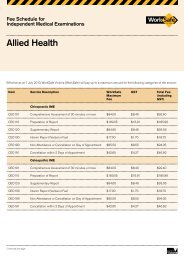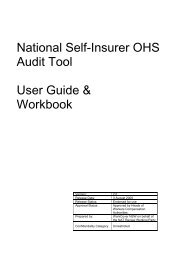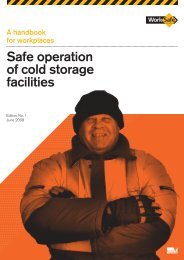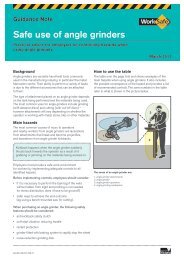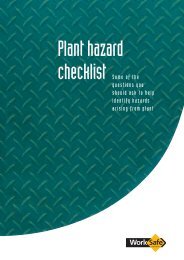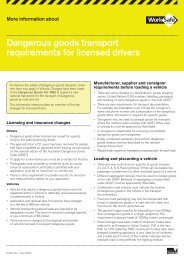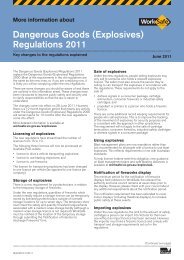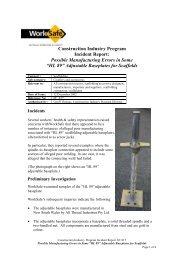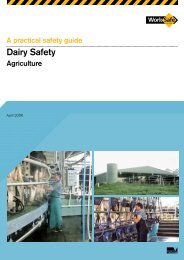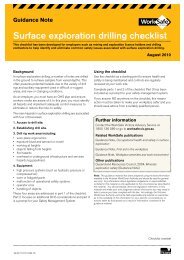Your health and safety guide to Manual handling - WorkSafe Victoria
Your health and safety guide to Manual handling - WorkSafe Victoria
Your health and safety guide to Manual handling - WorkSafe Victoria
- No tags were found...
You also want an ePaper? Increase the reach of your titles
YUMPU automatically turns print PDFs into web optimized ePapers that Google loves.
<strong>Your</strong> <strong>health</strong> <strong>and</strong><strong>safety</strong> <strong>guide</strong> <strong>to</strong><strong>Manual</strong> h<strong>and</strong>lingEDITION NO. 1 JUNE 2007HAZARD GUIDE
If this Hazard Guide does not contain an up-<strong>to</strong>-date More informationsheet, please go <strong>to</strong> www.worksafe.vic.gov.au <strong>to</strong> download the PDFor contact us on 1800 136 089 <strong>to</strong> request a printed copy.There’s plenty more informationabout <strong>health</strong> <strong>and</strong> <strong>safety</strong>...www.worksafe.vic.gov.au1800 136 089
<strong>Manual</strong> h<strong>and</strong>ling is the biggest causeof injuries in Vic<strong>to</strong>rian workplaces.Each year, thous<strong>and</strong>s of workers areinjured doing manual h<strong>and</strong>ling tasks thatare unsafe. The result can be debilitatinglong-term conditions that can severelyaffect a person’s quality of life.While most jobs involve some formof manual h<strong>and</strong>ling, it doesn’t have<strong>to</strong> be dangerous.This <strong>guide</strong> will help you underst<strong>and</strong> theproblem, <strong>and</strong> will explain what you need<strong>to</strong> do <strong>to</strong> make your workplace safe.
In this <strong>guide</strong>About the problem• What is manual h<strong>and</strong>ling?• What injuries can manualh<strong>and</strong>ling cause?<strong>Your</strong> legal duties• The law• Information for employers• Information for employees• Information for designers,manufacturers <strong>and</strong> suppliers• Compliance <strong>and</strong> enforcementHow <strong>to</strong> comply• Consult• Find• Fix• ReviewGlossary2 HAZARD GUIDE / MANUAL HANDLING
About the problemWhat is manual h<strong>and</strong>ling?<strong>Manual</strong> h<strong>and</strong>ling means using your body<strong>to</strong> exert force <strong>to</strong> h<strong>and</strong>le, support or restrainany object, including people or animals.It is not just lifting or carrying heavyobjects, it includes lifting, pushing, pulling,holding, lowering, throwing, carrying,packing, typing, assembling, cleaning,sorting <strong>and</strong> using <strong>to</strong>ols.The term is not limited <strong>to</strong> h<strong>and</strong>ling heavyobjects – pruning plants, stacking itemson<strong>to</strong> a shelf, helping a patient in<strong>to</strong> abath <strong>and</strong> even using a keyboard areall examples of manual h<strong>and</strong>ling.Hazardous manual h<strong>and</strong>ling involves:• repetitive or sustained application offorce, awkward postures or movements• tasks that people would find difficultdue <strong>to</strong> the degree of force applied(high force)• exposure <strong>to</strong> sustained vibration• manual h<strong>and</strong>ling of live peopleor animals• manual h<strong>and</strong>ling of unstable loadsthat are difficult <strong>to</strong> grasp or hold.What injuries canmanual h<strong>and</strong>ling cause?While not all manual h<strong>and</strong>ling taskswill cause injury, hazardous manualh<strong>and</strong>ling can lead <strong>to</strong> many seriousconditions, including:• muscle sprains <strong>and</strong> strains• back injuries• soft-tissue injuries <strong>to</strong> the wrists,arms, shoulders, neck or legs• abdominal hernias• chronic pain.Collectively, these conditions are knownas musculoskeletal disorders (MSDs).HAZARD GUIDE / MANUAL HANDLING3
<strong>Your</strong> legal dutiesThe lawOccupational Health <strong>and</strong> Safety Act 2004 (OHS Act)The OHS Act came in<strong>to</strong> effect on 1 July 2005. It sets out the key principles, duties<strong>and</strong> rights in relation <strong>to</strong> occupational <strong>health</strong> <strong>and</strong> <strong>safety</strong>. The duties imposed by theAct cover a wide variety of circumstances, recognising the need for a duty-holder <strong>to</strong>have flexibility in determining what needs <strong>to</strong> be done <strong>to</strong> comply.The OHS Act is based upon the following key <strong>health</strong> <strong>and</strong> <strong>safety</strong> principles:• All people – employees <strong>and</strong> the general public – should have the highest levelof protection against risks <strong>to</strong> <strong>health</strong> <strong>and</strong> <strong>safety</strong>.• Those who manage or control things that create <strong>health</strong> <strong>and</strong> <strong>safety</strong> risks in theworkplace are responsible for eliminating or reducing the risks, so far as isreasonably practicable.• Employers should be proactive in promoting <strong>health</strong> <strong>and</strong> <strong>safety</strong> in the workplace.• Information <strong>and</strong> ideas about risks <strong>and</strong> how <strong>to</strong> control them should be sharedbetween employers <strong>and</strong> employees.• Employees are entitled – <strong>and</strong> should be encouraged – <strong>to</strong> be represented in relation<strong>to</strong> <strong>health</strong> <strong>and</strong> <strong>safety</strong> issues.Occupational Health <strong>and</strong> Safety Regulations 2007 (OHS Regulations 2007)New Regulations for occupational <strong>health</strong> <strong>and</strong> <strong>safety</strong> came in<strong>to</strong> effect on 1 July 2007.The manual h<strong>and</strong>ling part of the OHS Regulations 2007 is intended <strong>to</strong> prevent <strong>and</strong>reduce the number <strong>and</strong> severity of injuries associated with manual h<strong>and</strong>ling tasks.To do this, the Regulations impose specifi c legal responsibilities on employers,employees, <strong>and</strong> designers, manufacturers <strong>and</strong> suppliers for the control of risk fromhazardous manual h<strong>and</strong>ling.4 HAZARD GUIDE / MANUAL HANDLING
EmployersAs an employer, you have a general duty<strong>to</strong> make your workplace safe, as well asspecific duties in relation <strong>to</strong> hazards suchas manual h<strong>and</strong>ling.You must identify any tasks that involvehazardous manual h<strong>and</strong>ling. If these taskspose a risk of musculoskeletal disorder,you must eliminate the risk.If it’s not reasonably practicable <strong>to</strong>eliminate the risk, you must reduce therisk, as far as reasonably practicable, by:• changing the workplace layout, theworkplace environment or the systemsof work• changing the objects used in the task, or• using mechanical aids.If there is still a risk after using thesemethods, you should control it byproviding information, training orinstruction.You must review (<strong>and</strong>, where necessary,revise) your risk controls if things change,if there is a report of an MSD in theworkplace, or at the request of a <strong>health</strong><strong>and</strong> <strong>safety</strong> representative.Employees<strong>Your</strong> employer is required <strong>to</strong> protectyou from manual h<strong>and</strong>ling injuries.At the same time, you have a generalduty <strong>to</strong> take reasonable care for your own<strong>health</strong> <strong>and</strong> <strong>safety</strong>, <strong>and</strong> that of others whomay be affected by your work, <strong>and</strong> <strong>to</strong>cooperate with your employer’s efforts<strong>to</strong> make the workplace safe.This may include using manual h<strong>and</strong>lingequipment properly, following workplacepolicies <strong>and</strong> procedures (e.g. using trolleys,team lifting), attending <strong>health</strong> <strong>and</strong> <strong>safety</strong>training, <strong>and</strong> not taking shortcuts thatcould increase manual h<strong>and</strong>ling risks.You can also help your employer make theworkplace safer by notifying them of anyhazardous manual h<strong>and</strong>ling tasks thatyou become aware of.HAZARD GUIDE / MANUAL HANDLING5
<strong>Your</strong> legal duties continuedDesigners, manufacturers<strong>and</strong> suppliersThe safe design of plant, substances,buildings <strong>and</strong> structures plays a criticalrole in reducing manual h<strong>and</strong>ling risksin workplaces.If you design plant, buildings or structures,or if you manufacture or supply plant orsubstances for use in a workplace, youmust ensure that your product is safe,as far as reasonably practicable.Manufacturers <strong>and</strong> suppliers must alsoprovide information on the safe use <strong>and</strong>maintenance of their product when givingor supplying the product <strong>to</strong> someone else.Compliance <strong>and</strong>enforcement<strong>WorkSafe</strong> applies a strategy of ‘constructivecompliance’ – a combination of incentives<strong>and</strong> deterrents – <strong>to</strong> improve workplace<strong>health</strong> <strong>and</strong> <strong>safety</strong>.This strategy recognises that real <strong>and</strong>sustainable improvement in workplace<strong>health</strong> <strong>and</strong> <strong>safety</strong> requires activeinvolvement from employers <strong>and</strong>employees in identifying hazards<strong>and</strong> controlling risks.<strong>WorkSafe</strong> inspec<strong>to</strong>rs have the primaryrole of targeting unsafe workplace activity,enforcing compliance with <strong>health</strong> <strong>and</strong><strong>safety</strong> laws, <strong>and</strong> providing guidance <strong>and</strong>advice on how <strong>to</strong> comply with those laws.Further information on workplaceinspections <strong>and</strong> <strong>WorkSafe</strong>’s enforcementpolicy is available through the <strong>WorkSafe</strong>Advisory Service (1800 136 089) or atwww.worksafe.vic.gov.au6 HAZARD GUIDE / MANUAL HANDLING
How <strong>to</strong> comply<strong>WorkSafe</strong> has a range of guidance materials <strong>to</strong> advise on the required processes<strong>and</strong> actions that duty-holders must take in order <strong>to</strong> meet their legal obligations.Compliance Codes, Health <strong>and</strong> Safety Solutions <strong>and</strong> Guidance Notes each providedetailed <strong>and</strong> specifi c advice for duty-holders seeking <strong>to</strong> comply with the OHSRegulations 2007. See also the enclosed More information sheet for a listing ofguidance materials related <strong>to</strong> <strong>Manual</strong> h<strong>and</strong>ling.ConsultEmployees’ expertise can make asignificant contribution <strong>to</strong> improvingworkplace <strong>health</strong> <strong>and</strong> <strong>safety</strong>.Regular, proactive consultation can helpidentify issues in the workplace <strong>and</strong> builda strong commitment <strong>to</strong> <strong>health</strong> <strong>and</strong> <strong>safety</strong>by including all views in the decisionmakingprocess.Under the OHS Act, employers mustconsult with employees when identifyinghazardous manual h<strong>and</strong>ling <strong>and</strong> makingdecisions about risk control.‘Employees’ includes independentcontrac<strong>to</strong>rs (<strong>and</strong> any employees of theindependent contrac<strong>to</strong>r(s)) who performwork which the employer has, or shouldhave, control over.If employees are represented by <strong>health</strong><strong>and</strong> <strong>safety</strong> representatives, the consultationmust involve those representatives –see <strong>Your</strong> <strong>health</strong> <strong>and</strong> <strong>safety</strong> <strong>guide</strong> <strong>to</strong>Consultation for further information.HAZARD GUIDE / MANUAL HANDLING7
How <strong>to</strong> comply continuedFindWhile not all manual h<strong>and</strong>ling tasks areunsafe, manual h<strong>and</strong>ling is hazardouswhen it involves any of the following:• repetitive or sustained force, movemen<strong>to</strong>r awkward posture• high force (<strong>to</strong> move or support anyobject that most people would finddifficult because of the effort it requires)• sustained vibration• h<strong>and</strong>ling live people or animals• h<strong>and</strong>ling loads that are unstable,unbalanced or diffi cult <strong>to</strong> hold.Some common examples of hazardousmanual h<strong>and</strong>ling tasks include:• moving large sacks of grain• using a jackhammer• sitting at a cramped desk <strong>and</strong> typingfor long periods at a time• using tin snips with grips that arewide apart• steering a heavily loaded trolleythrough a busy warehouse.Find all the tasks which have thesecharacteristics. Work out whether anyof the tasks you’ve found pose a risk.Forces, postures, movements <strong>and</strong> vibrationusually affect each other <strong>to</strong> increase therisk. For example, more force has <strong>to</strong> beexerted <strong>to</strong> pick up a box from the fl oorcompared with picking it up from abench at thigh height.The longer these tasks are done,the greater the risk.Environmental fac<strong>to</strong>rs such as heat,cold <strong>and</strong> lighting levels can alsoincrease the risk.Unexpected movement, high force<strong>and</strong> awkward postures.8 HAZARD GUIDE / MANUAL HANDLING
Repetitive twisting <strong>and</strong> bending.Sustained awkward posture.Exposure <strong>to</strong> sustained vibration.High force needed <strong>to</strong> grip <strong>and</strong> moveheavy sack.HAZARD GUIDE / MANUAL HANDLING9
How <strong>to</strong> comply continuedFixWork through the following list <strong>to</strong> controlmanual h<strong>and</strong>ling risks at your workplace.In many instances, a combination ofapproaches will result in the best solution.1. Eliminate the manual h<strong>and</strong>ling riskThe best option is <strong>to</strong> remove the hazardcompletely, so you should always try <strong>to</strong>do this first.Example: Get in the appropriateequipment <strong>to</strong> do the work mechanically,<strong>and</strong> train staff in its use.Eliminate high force.Eliminate s<strong>to</strong>oping <strong>and</strong> bending.Electronically adjustable beds eliminateawkward postures.10 HAZARD GUIDE / MANUAL HANDLING
2. Change the workplace, the objectsused or the way the job is doneIf you can’t remove the hazard, minimisethe risk by changing the workplace layout,environment or work methods, replacingthe objects used in the task, or usingmechanical equipment or aids.Example: Provide trolleys <strong>and</strong> adjustableworkbenches <strong>and</strong> seating, break loadsin<strong>to</strong> smaller quantities or use teamlifting.Eliminate carrying.3. Provide trainingIf the other measures will not <strong>to</strong>tally solvethe problem, or if they’re not suitable, youcan use information <strong>and</strong> training <strong>to</strong> showemployees how <strong>to</strong> do manual h<strong>and</strong>lingtasks with least risk.Example: Train people involved inteam lifting.ReviewIt’s important <strong>to</strong> review your risk controlsregularly <strong>to</strong> ensure they are implementedcorrectly <strong>and</strong> <strong>to</strong> moni<strong>to</strong>r their effectiveness.You need <strong>to</strong> review (<strong>and</strong>, if necessary,revise) your risk controls whenever anychanges are made <strong>to</strong> the workplace thatcould increase manual h<strong>and</strong>ling risks,such as changes <strong>to</strong> the way work is doneor <strong>to</strong> the <strong>to</strong>ols or equipment used.A review is also necessary if amusculoskeletal disorder is reported,if you become aware of any newinformation about any hazardousmanual h<strong>and</strong>ling tasks in the workplace,or if a <strong>health</strong> <strong>and</strong> <strong>safety</strong> representativerequests one.HAZARD GUIDE / MANUAL HANDLING 11
GLOSSARYEmployee – A person employed under a contract of employment or contract of training.Employer – A person who employs one or more people under contracts of employmen<strong>to</strong>r contracts of training.Hazard – A potential source of harm or injury. The potential <strong>to</strong> cause injury, illness or disease.Health <strong>and</strong> <strong>safety</strong> representative (HSR) – A member of a designated work groupelected <strong>to</strong> represent employees on matters relating <strong>to</strong> occupational <strong>health</strong> <strong>and</strong> <strong>safety</strong>.<strong>Manual</strong> h<strong>and</strong>ling – Any activity requiring the use of force exerted by a person <strong>to</strong> lift,push, pull, carry or otherwise move, hold or restrain any object.Musculoskeletal disorder (MSD) – An injury, illness or disease that arises in whole or in partfrom manual h<strong>and</strong>ling in the workplace, whether occurring suddenly or over a prolongedperiod of time.Plant – Any machinery, equipment, appliance, implement or <strong>to</strong>ol; any component ofany of these things; <strong>and</strong> anything fi tted, connected or related <strong>to</strong> any of these things.Reasonably practicable – See section 20(2) of the OHS Act <strong>and</strong> the <strong>WorkSafe</strong> Position onHow <strong>WorkSafe</strong> applies the law in relation <strong>to</strong> reasonably practicable.12 HAZARD GUIDE / MANUAL HANDLING
In this seriesHazards<strong>Your</strong> <strong>health</strong> <strong>and</strong> <strong>safety</strong> <strong>guide</strong> <strong>to</strong> asbes<strong>to</strong>s<strong>Your</strong> <strong>health</strong> <strong>and</strong> <strong>safety</strong> <strong>guide</strong> <strong>to</strong> confined spaces<strong>Your</strong> <strong>health</strong> <strong>and</strong> <strong>safety</strong> <strong>guide</strong> <strong>to</strong> dangerous goods<strong>Your</strong> <strong>health</strong> <strong>and</strong> <strong>safety</strong> <strong>guide</strong> <strong>to</strong> falls prevention<strong>Your</strong> <strong>health</strong> <strong>and</strong> <strong>safety</strong> <strong>guide</strong> <strong>to</strong> hazardous substances<strong>Your</strong> <strong>health</strong> <strong>and</strong> <strong>safety</strong> <strong>guide</strong> <strong>to</strong> lead<strong>Your</strong> <strong>health</strong> <strong>and</strong> <strong>safety</strong> <strong>guide</strong> <strong>to</strong> manual h<strong>and</strong>ling<strong>Your</strong> <strong>health</strong> <strong>and</strong> <strong>safety</strong> <strong>guide</strong> <strong>to</strong> noise<strong>Your</strong> <strong>health</strong> <strong>and</strong> <strong>safety</strong> <strong>guide</strong> <strong>to</strong> plantIndustries<strong>Your</strong> <strong>health</strong> <strong>and</strong> <strong>safety</strong> <strong>guide</strong> <strong>to</strong> construction<strong>Your</strong> <strong>health</strong> <strong>and</strong> <strong>safety</strong> <strong>guide</strong> <strong>to</strong> forestry<strong>Your</strong> <strong>health</strong> <strong>and</strong> <strong>safety</strong> <strong>guide</strong> <strong>to</strong> foundries<strong>Your</strong> <strong>health</strong> <strong>and</strong> <strong>safety</strong> <strong>guide</strong> <strong>to</strong> major hazard facilities<strong>Your</strong> <strong>health</strong> <strong>and</strong> <strong>safety</strong> <strong>guide</strong> <strong>to</strong> minesSubjects<strong>Your</strong> <strong>health</strong> <strong>and</strong> <strong>safety</strong> <strong>guide</strong> <strong>to</strong> communicating across languages<strong>Your</strong> <strong>health</strong> <strong>and</strong> <strong>safety</strong> <strong>guide</strong> <strong>to</strong> consultation<strong>Your</strong> <strong>health</strong> <strong>and</strong> <strong>safety</strong> <strong>guide</strong> <strong>to</strong> controlling OHS hazards <strong>and</strong> risks<strong>Your</strong> <strong>health</strong> <strong>and</strong> <strong>safety</strong> <strong>guide</strong> <strong>to</strong> licensing <strong>and</strong> registrations<strong>Your</strong> <strong>health</strong> <strong>and</strong> <strong>safety</strong> <strong>guide</strong> <strong>to</strong> workplace amenities <strong>and</strong> first aidVisit www.worksafe.vic.gov.au for online guidance on all of these<strong>to</strong>pics <strong>and</strong> more…The information presented in <strong>Your</strong> <strong>health</strong> <strong>and</strong> <strong>safety</strong> <strong>guide</strong> <strong>to</strong> manual h<strong>and</strong>ling is intended for general use only. It should not beviewed as a defi nitive <strong>guide</strong> <strong>to</strong> the law, <strong>and</strong> should be read in conjunction with the Occupational Health <strong>and</strong> Safety Act 2004.This publication is protected by copyright. The Vic<strong>to</strong>rian WorkCover Authority encourages the free transfer, copying <strong>and</strong>printing of this publication if such activities support the purposes <strong>and</strong> intent for which the publication was developed.<strong>WorkSafe</strong> Vic<strong>to</strong>ria is a division of the Vic<strong>to</strong>rian WorkCover Authority.
<strong>WorkSafe</strong>Vic<strong>to</strong>ria<strong>WorkSafe</strong> Advisory Service222 Exhibition StreetMelbourne VIC 3000Phone 03 9641 1444Toll-free 1800 136 089Email info@worksafe.vic.gov.auHead Office222 Exhibition StreetMelbourne VIC 3000Phone 03 9641 1555Toll-free 1800 136 089Website www.worksafe.vic.gov.auLocal OfficesBallarat 03 5338 4444Bendigo 03 5443 8866D<strong>and</strong>enong 03 8792 9000Geelong 03 5226 1200Melbourne(628 Bourke Street) 03 9941 0558Mildura 03 5021 4001Mulgrave 03 9565 9444Pres<strong>to</strong>n 03 9485 4555Sheppar<strong>to</strong>n 03 5831 8260Traralgon 03 5174 8900Wangaratta 03 5721 8588Warrnambool 03 5564 3200YGT007/01/05.07 www.worksafe.vic.gov.au


